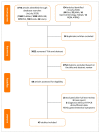COVID-19 gastrointestinal manifestations: a systematic review
- PMID: 33263693
- PMCID: PMC7723378
- DOI: 10.1590/0037-8682-0714-2020
COVID-19 gastrointestinal manifestations: a systematic review
Abstract
Introduction: The pandemic caused by severe acute respiratory syndrome coronavirus 2 (SARS-CoV-2) infection has greatly challenged public health worldwide. A growing number of studies have reported gastrointestinal (GI) symptoms. We performed a systematic review of GI symptoms associated with coronavirus disease 2019 (COVID-19) as well as of the serum levels of biomarkers related to liver function and lesion in SARS-CoV-2-infected individuals.
Methods: We surveyed relevant articles published in English, Spanish, and Portuguese up to July, 2020 in the PubMed, MEDLINE, SciELO, LILACS, and BVS databases. Moreover, we surveyed potentially important articles in journals such as the NEJM, JAMA, BMJ, Gut, and AJG.
Results: This systematic review included 43 studies, including 18,246 patients. Diarrhea was the most common GI symptom, affecting 11.5% of the patients, followed by nausea and vomiting (6.3%) and abdominal pain (2.3%). With regard to clinical severity, 17.5% of the patients were classified as severely ill, whereas 9.8% of them were considered to have a non-severe disease. Some studies showed increased aspartate transaminase and alanine aminotransferase levels in a portion of the 209 analyzed patients and two studies.
Conclusions: Our results suggest that digestive symptoms are common in COVID-19 patients. In addition, alterations in cytolysis biomarkers could also be observed in a lesser proportion, calling attention to the possibility of hepatic involvement in SARS-CoV-2-infected individuals.
Conflict of interest statement
Figures




References
-
- Phelan AL, Katz R, Gostin LO. The Novel Coronavirus Originating in Wuhan, China: Challenges for Global Health Governance. JAMA. 2020;323(8):709–710. - PubMed
-
- World Health Organization . Coronavirus disease 2019 (COVID-19) situation report 192; 2020. WHO; Geneva: 2020. [2020 september 4]. Available from: https://www.who.int/docs/default-source/coronaviruse/situation-reports/2....
Publication types
MeSH terms
LinkOut - more resources
Full Text Sources
Medical
Miscellaneous

